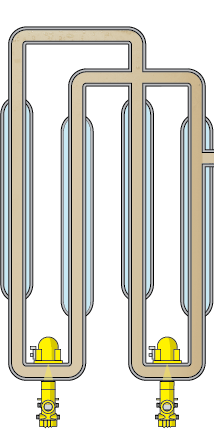How loop reactors help keep us organized in the New Year: Application of the month
We made it through the holidays, and now it’s time to put all the decorations away. But instead of tossing all the decorations back into the hodgepodge of differently sized boxes we had them in a few months ago, we decided to get organized. This required going to the store and purchasing a number of similarly-sized, stackable storage bins. There were so many choices.
The department stores know everyone is attempting to get organized in the new year, so they were fully stocked with aisles and aisles of plastic bins, boxes, and totes. The petrochemical companies that manufacture the polypropylene and polyethylene pellets that make up these storage containers had been busy. Making these plastic building blocks is a large, industrial process comprising of multiple steps. One of those steps is the loop reactor.
A towering, ongoing reaction
The loop reactor is an easily recognizable application at a polyolefin plant because it towers over everything else. This application looks like a tube or pipe positioned into a tall, skinny loop. The reaction inside is constant because products from the reaction are continuously withdrawn as new reactants are being fed into it.
At petrochemical plants producing polyethylene and polypropylene, the process begins when ethylene or propylene is mixed with a catalyst. The reaction inside the loop reactor turns monomers into polymers, and as the reaction progresses, it transforms from being mostly a liquid to a slurry. During this time, solids are being siphoned away and moving onto the next step in the process while new materials are being introduced.
Operators monitor the density inside the pipe to optimize the reaction and prevent plugging inside the pipe. Maximizing the outcome of the reaction is critical for efficiency, but a plug is an even more costly error. Plugging will initiate a shutdown, resulting in significant downtime and corresponding losses in production. However, getting an accurate density measurement and preventing plugs in this ongoing reaction is easier said than done.
Radiometric density measurement is up for the job
Being able to monitor the density inside the loop reactor without contacting the reaction requires a radiometric solution. Radiometric sources and sensors mount externally on the reactor, so there’s no interference with the process and no need for a process connection.
The MiniTrac 31 is a compact, lightweight detector used to measure density in pipes. It operates by detecting radiation from a radiometric source mounted opposite the sensor, and it infers the density. These sensors provide accurate measurements with a high resolution to optimize the process and prevent shutdowns. This white paper goes into great detail on how radiometric measurements work.
A radiometric density sensor installed at the bottom of the loop reactor can help improve the loop reactor process for petrochemical plants manufacturing polypropylene and polyethylene in a similar way those plastic storage containers can help us improve the organization in our homes. It all comes full circle – just like the loop reactor.
Related products
Export this article
Download as PDFShare this article
Comments ({{comments.length}})
{{getCommentAuthor(comment, "Anonymous")}} {{comment.timestamp | date : "dd.MM.yyyy HH:mm" }}
{{comment.comment}}


